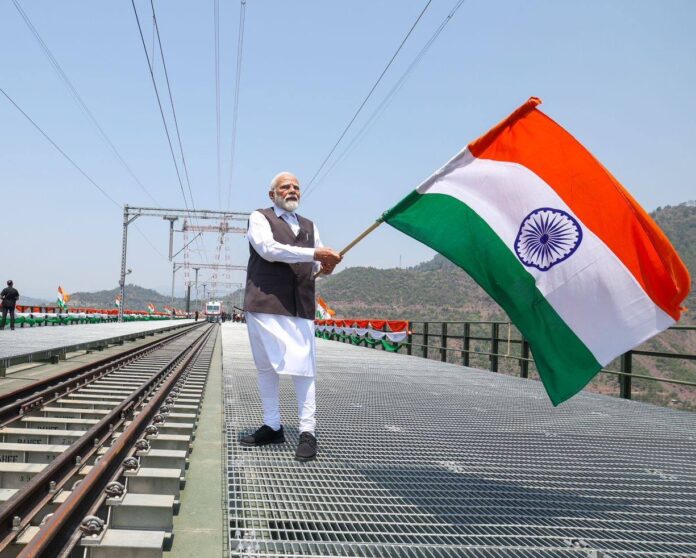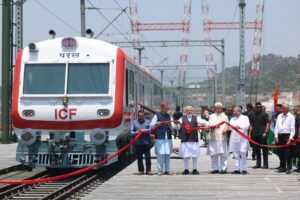
— Qalam Times News Network
REASI, JAMMU & KASHMIR | 6 June 2025 — In a historic milestone for Indian infrastructure and national integration, Prime Minister Narendra Modi on Friday inaugurated the Chenab Rail Bridge, the world’s tallest railway arch bridge, situated in Jammu and Kashmir’s Reasi district. This inauguration marks a turning point in the long-awaited dream of rail connectivity between the Kashmir Valley and the rest of India.
Built at a staggering height of 359 metres (1,178 feet) above the Chenab River, the bridge surpasses the Eiffel Tower by 35 metres and stands as a symbol of India’s engineering prowess. Spanning 1,315 metres in length, this steel arch structure is part of the Udhampur-Srinagar-Baramulla Rail Link (USBRL) project — a ₹35,000 crore, 272-kilometre-long all-weather rail corridor traversing some of the most rugged and geologically complex terrain in the Himalayan region.
A Marvel of Modern Engineering
The Chenab Bridge is constructed with over 30,000 tonnes of specially fabricated steel and designed to withstand extreme seismic activity, high-speed winds up to 260 km/h, and severe winter conditions. The bridge is earthquake-resistant and includes blast-proof technology, a first in Indian Railways construction, considering the sensitive location of the project. Special sensors and health monitoring systems have been embedded for real-time structural assessment.
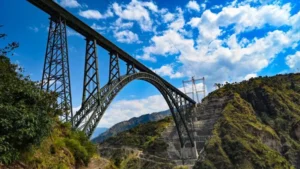
The bridge’s single arch — the defining feature of the design — was assembled using the cable crane method, a sophisticated construction technique rarely used in the world. The entire structure has a lifespan of over 120 years and is expected to function as a critical strategic asset as well as a tourism attraction.
Flagging Off Vande Bharat to Srinagar
Alongside the bridge inauguration, PM Modi also flagged off the first Vande Bharat Express connecting Katra (base of Shri Mata Vaishno Devi shrine) to Srinagar, making it the first-ever train service to run directly from Jammu to the heart of the Kashmir Valley.
The high-speed train will reduce the travel time between Katra and Srinagar from 6 hours to just under 3 hours, enhancing connectivity for pilgrims, tourists, traders, and students. This development is seen as a major breakthrough in bringing Kashmir into the national transport mainstream.
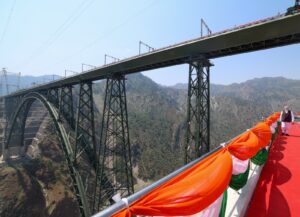
Nation-Building Through Connectivity
Addressing a large gathering at the inauguration site, PM Modi hailed the Chenab Rail Bridge as a “symbol of New India’s resolve, resilience, and reach.” He thanked the engineers, labourers, and security forces who worked under extreme conditions for nearly two decades to bring the project to life.
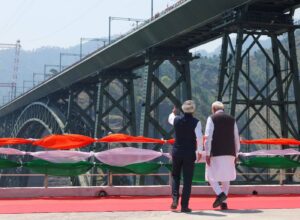
“This bridge is not just a structure of steel and concrete,” the Prime Minister said. “It is a lifeline that will connect hearts, economies, and aspirations — especially of the youth of Jammu and Kashmir. It is a promise fulfilled, a dream realized.”
Strategic, Economic, and Social Impact
The USBRL and associated infrastructure projects, including the Anji Khad Cable-Stayed Bridge (India’s first such rail bridge), will provide seamless all-weather railway access from Udhampur to Baramulla, boosting trade, tourism, and employment. These links will also significantly reduce dependence on the vulnerable Jammu-Srinagar National Highway, which is often closed due to landslides and snow.
For the Indian Armed Forces, the connectivity offers improved strategic mobility and faster logistics in a region of vital national security interest. Officials have also hinted that this network could, in future, form a crucial leg of international rail freight through Central Asia under larger connectivity frameworks like INSTC or potential regional corridors.
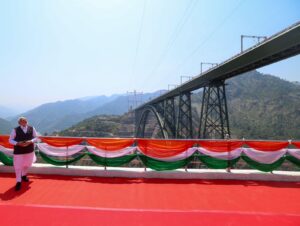
Political Significance and Local Engagement
PM Modi’s visit — his first to the valley since the Pahalgam terror attack and the subsequent launch of Operation Sindoor — carried heavy symbolic and political weight. The event was attended by Railway Minister Ashwini Vaishnaw, J&K Lieutenant Governor Manoj Sinha, former Chief Minister Omar Abdullah, and senior officials of the Railway Board, Northern Railways, and DRDO.
Modi also took time to meet and thank thousands of workers, many of whom hailed from remote regions of India. Special acknowledgment was given to the labour force that worked year-round, in freezing winters and scorching summers, under tight security in the high-risk zone.
The Road Ahead
The full commissioning of the USBRL project — which includes 38 tunnels (the longest being 12.75 km), 927 bridges, and cutting-edge technology like ballast-less tracks and GPS-enabled monitoring — is expected to revolutionize rail travel in the Himalayas. Indian Railways has hinted at future semi-high-speed services and luxury rail tourism options for the Kashmir sector.

As the Vande Bharat train rumbled across the Chenab arch for the first time, it wasn’t just a train service being flagged off — it was the beginning of a new chapter in Kashmir’s socio-economic future, driven by steel, speed, and a national vision.
— Reported by Qalam Times News Network

